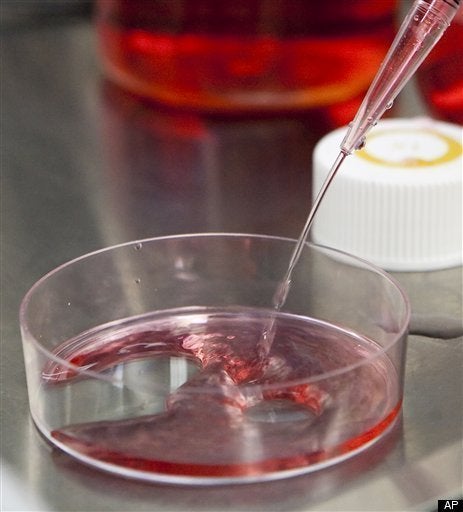
Camouflaged in the politics, controversy, and hype surrounding stem cells have been two stunning and unexpected dividends: the ability to study diseases in a petrie dish and a new way to think about cancer. This is separate from the most well-publicized stem cell story: the potential of embryonic stem cells to morph into any cell in the body and replace injured or defective cells -- for example in diabetes, Parkinson's, and spinal cord injury.
Human embryonic stem cells (HES cells) are collected from unused embryos created by in-vitro fertilization. About two years ago, scientists figured out a way to turn ordinary skin cells into stem cells. This was a huge deal. These cells -- called "induced pluripotents stem cells" (IPS cells) -- are not identical to HES cells and may not be quite as nimble in morphing into other cells. But they are electrifying the field because diseases can now be studied outside the body -- in a petrie dish. For example, researchers have taken skin from patients with ALS (Lou Gehrig's disease), turned them into stem cells, then turned the stem cells into the kind of nerve cells (motor neurons) damaged in the disease. Now -- for the first time -- they can study living nerves from somebody with ALS and see how they differ from normal nerves. This work is going full steam ahead right now -- for instance, in a cooperative effort between Harvard and Columbia, orchestrated and supported by Project ALS.
Aside from HES and IPS cells, there are "adult stem cells." They are normally present throughout our bodies and help us replace cells that are damaged. They've been found in many organs, including breast, colon, and blood (in fact, it's the adult stem cells in bone marrow that are the basis for bone marrow transplants). In recent years, researchers have discovered that these normal stem cells can produce cancer stem cells that then create cancers - for example, breast cancer, colon cancer, and leukemia. One reason why this discovery is so important is that it may help explain why cancers recur despite chemotherapy. After producing "regular" cancer cells, cancer stem cells can stop dividing and become dormant -- thereby escaping chemotherapy, which usually works by destroying cancer cells only as they divide. The "regular" cancer cells -- which are still dividing -- may be destroyed by the chemotherapy. But the dormant cancer stem cell may be able to play possum for years, then awaken, start dividing again, and cause a recurrence.
Supported by the California Institute for Regenerative Medicine, Dr. Catriona Jaimeson and her team at UC San Diego are testing a drug that targets the cancer stem cell responsible for a kind of leukemia. The drug was developed by TargeGen and is now being studied in a clinical trial. When I recently visited Dr. Jaimeson, she introduced me to a patient who had been on the brink of developing leukemia and is now living a normal life after taking the experimental drug. The hope is to discover ways of identifying and targeting cancer stem cells in a variety of cancers.
Even if everything goes right, therapies based on all this newly discovered stem cell biology won't be widely available for years. But patients are desperate for solutions now. And their best hope is for us to support basic scientific research. You never know where research will lead, what astounding, unpredictable discovery will emerge that changes the way we think.
Finally, here's an update on the quest to replace damaged body parts using stem cells. Later this year, Dr. Hans Keirstead of UC Irvine, working with Geron Corporation, plans to begin the first FDA-approved trial of human embryonic stem cells to treat paralyzed patients within two weeks of injury. It starts.
Click here to see "Where America Stands: Stem Cell Research." The animations created by brilliant CBS graphics artist, David Rosen, are worth ten thousand of my words in explaining the latest breakthroughs in stem cell research.
Click here to see this week's CBS Doc Dot Com, a portrait of Dr. John Kessler and his quest to use stem cells to help his paralyzed daughter walk again.
Stem Cell Research: A Father's Fight
Dr. John Kessler is a leader in the field of stem cell research at Northwestern University. His motivation is to see his daughter, who is paralyzed, walk again. Dr. Jon LaPook reports.
Watch CBS News Videos Online
The Kesslers' Life-Changing Day
Dr. John Kessler and Allison Kessler describe the day that changed both of their lives. A skiing accident left Allison paralyzed and led to her father's research in spinal cord injury.
Watch CBS News Videos Online
Stem Cells and Controversy
A recent advance in stem cell research has allowed scientists to use human skin cells to create stem cells. Are human embryonic stem cells still needed? Dr. Jon LaPook talks with neurologist Dr. John Kessler.